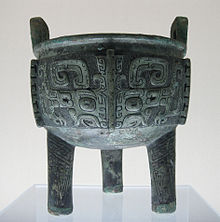| Ding | |||||||||||||||||||||||||||||
|---|---|---|---|---|---|---|---|---|---|---|---|---|---|---|---|---|---|---|---|---|---|---|---|---|---|---|---|---|---|
 A ding from the late Shang dynasty | |||||||||||||||||||||||||||||
| Chinese | 鼎 | ||||||||||||||||||||||||||||
| |||||||||||||||||||||||||||||

Ding (Chinese: 鼎; pinyin: dǐng) are prehistoric and ancient Chinese cauldrons standing upon legs with a lid and two fancy facing handles. They are one of the most important shapes used in Chinese ritual bronzes. They were made in two shapes: round vessels with three legs and rectangular ones with four, the latter often called fāng dǐng (Chinese: 方鼎; lit. 'square ding'). They were used for cooking, storage, and ritual offerings to the gods or to ancestors.
The earliest recovered examples are pre-Shang ceramic ding at the Erlitou site,[1] but they are better known from the Chinese Bronze Age, particularly after the Zhou deemphasized the ritual use of huangjiu alcohol practiced by the Shang kings.[2] Under the Zhou, the ding and the privilege to perform the associated rituals became symbols of authority.[3] The number of permitted ding varied according to one's rank in the Chinese nobility: the Nine Ding of the Zhou kings were a symbol of their rule over all China but were lost by the first emperor, Shi Huangdi in the late 3rd century BCE.[4] Subsequently, imperial authority was represented by the Heirloom Seal of the Realm, carved out of the sacred Heshibi; it was lost at some point during the Five Dynasties after the collapse of the Tang.
- ^ Fong 1980, p. 2.
- ^ Chen, Jianming; Jay Xu; Fu Juliang (2011). Along the Yangzi River: Regional Culture of the Bronze Age from Hunan. New York: Art Media Resources, Ltd. pp. 23–24. ISBN 978-0-9774054-6-6.
- ^ Lawton, Thomas (1982). Chinese Art of the Warring States Period: Change and Continuity 480-222 B.C. Washington, D.C.: Smithsonian Institution Press. p. 23. ISBN 978-0-934686-39-6.
- ^ Food for Thought: Archeological Findings Point to Chinese Dietary Culture Archived 2007-02-04 at the Wayback Machine